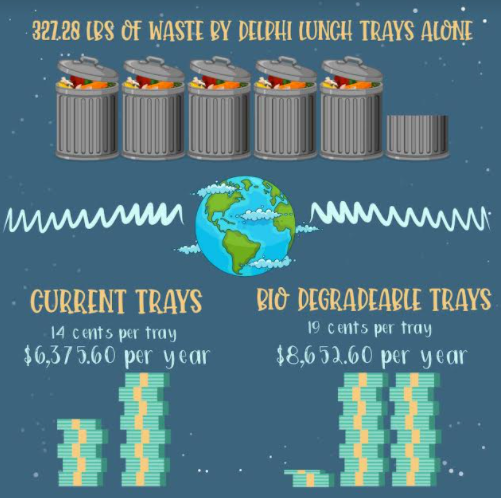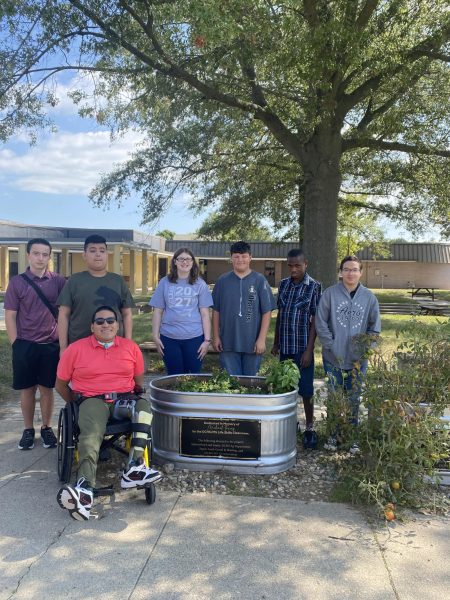The impact of disposable lunch trays

With Earth Day just behind us and my burning passion to reduce my carbon footprint always pressing, a question came to my mind the other day during lunch: The school has been serving food on foam trays on and off for the majority of the school year. What impact does this have on our environment?
The choice of using disposable lunch trays was a result of low staffing. Our school simply doesn’t have enough cafeteria staff members to wash all the incoming lunch trays throughout the day. So, the school turned to disposable lunch trays.
At first the school was primarily using a black five compartment tray made of polystyrene plastic, a foam-like material. This type of plastic cannot be recycled in traditional means and has limited recycling options. It is formed from styrene, a liquid hydrocarbon, which takes an estimated 500 years to decompose. The production of this plastic creates large amounts of hazardous waste. On top of that, if disposed of improperly, polystyrene can leach chemicals into the environment and harm water sources.
According to the Indiana Department of Environmental Management (IDEM), presently Indiana has the most polluted waterways of any state, over 25,000 miles that are too polluted for recreation and swimming. Another study, conducted by Lindsay L. Hylton, shows the vast extent of the microplastics, small pieces of plastic that have broken off, in the Indiana waterways.
Many of us don’t think about the impact that plastics and other unnatural items have on the environment, but maybe if I put some numbers to a page it will make it easier for you to see.
On average, 230 to 275 students eat school lunches every day. We can just take the median of 252.2 or 253 students to calculate the amount of waste per day then per school year. According to the DCHS lunch ladies, we use the black polystyrene trays about 3 out of the 5 schools days a week. We attend 180 days in a year at school in the state of Indiana and the average weight of a polystyrene tray is .02156 pounds. With these numbers we can calculate the average waste to be around 327.28 pounds per school year. This number does not account for the plastic forks, spoons, straws, or wrappers that inevitably make their way into the bin.
However, when trying to solve this environmental issue, we also have to take into account the economics of solving this problem. Although DCHS uses two different types of trays, the polystyrene plastic and a brown pulp fiber tray that is biodegradable, we most often use the polystyrene. For the sake of a more simple comparison, let’s compare the cost of using polystyrene each day for an entire school year versus using the brown pulp fiber. Polystyrene is the cheaper option of the two we currently use at .14 cents per tray. For 5 days of usage for 180 school days that’s roughly $6,375.60. On the other hand, if we started using the more environmentally-friendly brown pulp fiber biodegradable trays daily at .19 cents per day, the cost would be roughly $8,652.60 every year.
In the end, it would only cost the school around $2,000 a year to go biodegradable. In the grand scheme of the school budget, $2,000 doesn’t equate to much, but would it cost the school to remove disposable trays altogether? As mentioned earlier, this would require hiring another cafeteria staff member. According to the cafeteria staff, most members start at $12.00/hour, working for about 7 hours a day on average. With that, it would cost the school around $15,120 to pay for another staff member for the 180 days we are required to go to school. This new employee could wash all the trays and remove the need for disposable ones.
The school might be saving some money, but at what cost? Currently, the school corporation is saving a few thousand dollars, but one member of our community doesn’t receive a job and a large amount of chemical leaching plastic is placed into the ground. The alternative route of buying biodegradable trays doesn’t save money, but it does set a precedent for the students and it’s not as expensive as hiring a new member. So, why not spend a nickel more a day per student to save the environment that we all love so dearly, and to keep the school’s pockets full.
For more information:
New report finds Indiana has the most dirty waterways in U.S. Agriculture is main culprit.
Water Quality Impaired Waters 303d (2016)
MICROPLASTIC POLLUTION IN INDIANA’S WHITE RIVER: AN EXPLORATORY STUDY

Ava is a senior at Delphi Community High School and is in her third year of Parnassus. She is a member of the DCHS plays, musicals, and French club. She...























